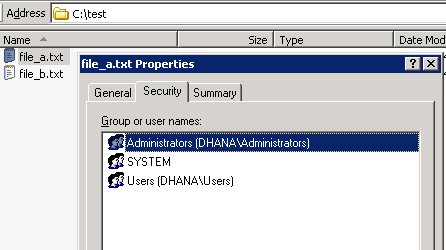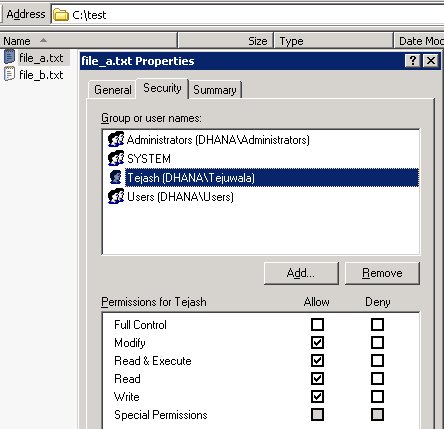Using security APIs you can set NTFS permissions in more technical term you can change ACL (Access Control List) for a user.
Here for demo purpose I have created a user called "tejuwala" and I have created a folder c:\test and two files c:\test\file_a.txt and c:\file_b.txt . User tejuwala dont have access to any of this file. In this example I will show you how you can set folder or file permissions using API.
Permissions on file_a.txt Before running this program

Permissions on file_a.txt After running this program

To Run this demo
-> Create a Standard Exe Project (Project1)
-> Add a Module file (Module1.bas)
Add following controls on the Form1
-> 5 checkbox rename them to chkFull, chkModify, chkReadAndExe, chkRead, chkWrite
-> 2 textbox rename them to txtPath and txtUser
-> 1 commandbutton rename it to cmdSet
Copy following code into Form1
Form1.frm |
 Click here to copy the following block Click here to copy the following block | Private Sub chkFull_Click()
ResetPermissions
End Sub
Sub ResetPermissions()
If chkFull.Value = 1 Then
chkModify.Value = 1
chkReadandExe.Value = 1
chkRead.Value = 1
chkWrite.Value = 1
ElseIf chkModify.Value = 1 Then
chkModify.Value = 1
chkReadandExe.Value = 1
chkRead.Value = 1
chkWrite.Value = 1
ElseIf chkReadandExe.Value = 1 Then
chkReadandExe.Value = 1
chkRead.Value = 1
End If
End Sub
Private Sub chkModify_Click()
If chkModify.Value = 0 Then
chkFull.Value = 0
End If
ResetPermissions
End Sub
Private Sub chkRead_Click()
If chkRead.Value = 0 Then
chkFull.Value = 0
chkModify.Value = 0
chkReadandExe.Value = 0
End If
ResetPermissions
End Sub
Private Sub chkReadandExe_Click()
If chkReadandExe.Value = 0 Then
chkFull.Value = 0
End If
ResetPermissions
End Sub
Private Sub chkWrite_Click()
If chkWrite.Value = 0 Then
chkFull.Value = 0
chkModify.Value = 0
End If
ResetPermissions
End Sub
Private Sub cmdClose_Click()
Unload Me
End Sub
Private Sub cmdSet_Click()
Dim sUserName As String
Dim sPath As String
Dim lPermission As Long
sUserName = Trim$(CStr(txtUser.Text))
sPath = Trim$(CStr(txtPath.Text))
If chkFull.Value = 1 Then
lPermission = GENERIC_ALL
SetAccess sUserName, sPath, lPermission
ElseIf chkModify.Value = 1 Then
lPermission = GENERIC_READ Or GENERIC_EXECUTE Or DELETE Or GENERIC_WRITE
SetAccess sUserName, sPath, lPermission
Else
If chkReadandExe.Value = 1 Then
lPermission = GENERIC_READ Or GENERIC_EXECUTE
SetAccess sUserName, sPath, lPermission
Else
If chkRead.Value = 1 Then
lPermission = GENERIC_READ
SetAccess sUserName, sPath, lPermission
End If
If chkWrite.Value = 1 Then
lPermission = GENERIC_WRITE
SetAccess sUserName, sPath, lPermission
End If
End If
End If
End Sub |
Copy following code into Module1.bas
Module1.bas |
 Click here to copy the following block Click here to copy the following block |
Public Const GMEM_MOVEABLE = &H2
Public Const LMEM_FIXED = &H0
Public Const LMEM_ZEROINIT = &H40
Public Const LPTR = (LMEM_FIXED + LMEM_ZEROINIT)
Public Const GENERIC_READ = &H80000000
Public Const GENERIC_ALL = &H10000000
Public Const GENERIC_EXECUTE = &H20000000
Public Const GENERIC_WRITE = &H40000000
Public Const DACL_SECURITY_INFORMATION = &H4
Public Const SECURITY_DESCRIPTOR_REVISION = 1
Public Const SECURITY_DESCRIPTOR_MIN_LENGTH = 20
Public Const SD_SIZE = (65536 + SECURITY_DESCRIPTOR_MIN_LENGTH)
Public Const ACL_REVISION2 = 2
Public Const ACL_REVISION = 2
Public Const MAXDWORD = &HFFFFFFFF
Public Const SidTypeUser = 1
Public Const AclSizeInformation = 2
Public Const OBJECT_INHERIT_ACE = &H1
Public Const CONTAINER_INHERIT_ACE = &H2
Public Const NO_PROPAGATE_INHERIT_ACE = &H4
Public Const INHERIT_ONLY_ACE = &H8
Public Const INHERITED_ACE = &H10
Public Const VALID_INHERIT_FLAGS = &H1F
Public Const DELETE = &H10000
Type ACE_HEADER
AceType As Byte
AceFlags As Byte
AceSize As Integer
End Type
Public Type ACCESS_DENIED_ACE
Header As ACE_HEADER
Mask As Long
SidStart As Long
End Type
Type ACCESS_ALLOWED_ACE
Header As ACE_HEADER
Mask As Long
SidStart As Long
End Type
Type ACL
AclRevision As Byte
Sbz1 As Byte
AclSize As Integer
AceCount As Integer
Sbz2 As Integer
End Type
Type ACL_SIZE_INFORMATION
AceCount As Long
AclBytesInUse As Long
AclBytesFree As Long
End Type
Type SECURITY_DESCRIPTOR
Revision As Byte
Sbz1 As Byte
Control As Long
Owner As Long
Group As Long
sACL As ACL
Dacl As ACL
End Type
Declare Function GetComputerName Lib "kernel32" Alias "GetComputerNameA" (ByVal lpBuffer As String, nSize As Long) As Long
Declare Function GetUserName Lib "advapi32.dll" Alias "GetUserNameA" (ByVal lpBuffer As String, nSize As Long) As Long
Declare Function LookupAccountName Lib "advapi32.dll" Alias "LookupAccountNameA" (lpSystemName As String, ByVal lpAccountName As String, sid As Any, cbSid As Long, ByVal ReferencedDomainName As String, cbReferencedDomainName As Long, peUse As Long) As Long
Declare Function InitializeSecurityDescriptor Lib "advapi32.dll" (pSecurityDescriptor As SECURITY_DESCRIPTOR, ByVal dwRevision As Long) As Long
Declare Function GetSecurityDescriptorDacl Lib "advapi32.dll" (pSecurityDescriptor As Byte, lpbDaclPresent As Long, pDacl As Long, lpbDaclDefaulted As Long) As Long
Declare Function GetFileSecurityN Lib "advapi32.dll" Alias "GetFileSecurityA" (ByVal lpFileName As String, ByVal RequestedInformation As Long, ByVal pSecurityDescriptor As Long, ByVal nLength As Long, lpnLengthNeeded As Long) As Long
Declare Function GetFileSecurity Lib "advapi32.dll" Alias "GetFileSecurityA" (ByVal lpFileName As String, ByVal RequestedInformation As Long, pSecurityDescriptor As Byte, ByVal nLength As Long, lpnLengthNeeded As Long) As Long
Declare Function GetAclInformation Lib "advapi32.dll" (ByVal pAcl As Long, pAclInformation As Any, ByVal nAclInformationLength As Long, ByVal dwAclInformationClass As Long) As Long
Public Declare Function EqualSid Lib "advapi32.dll" (pSid1 As Byte, ByVal pSid2 As Long) As Long
Declare Function GetLengthSid Lib "advapi32.dll" (pSid As Any) As Long
Declare Function InitializeAcl Lib "advapi32.dll" (pAcl As Byte, ByVal nAclLength As Long, ByVal dwAclRevision As Long) As Long
Declare Function GetAce Lib "advapi32.dll" (ByVal pAcl As Long, ByVal dwAceIndex As Long, pace As Any) As Long
Declare Function AddAce Lib "advapi32.dll" (ByVal pAcl As Long, ByVal dwAceRevision As Long, ByVal dwStartingAceIndex As Long, ByVal pAceList As Long, ByVal nAceListLength As Long) As Long
Declare Function AddAccessAllowedAce Lib "advapi32.dll" (pAcl As Byte, ByVal dwAceRevision As Long, ByVal AccessMask As Long, pSid As Byte) As Long
Public Declare Function AddAccessDeniedAce Lib "advapi32.dll" (pAcl As Byte, ByVal dwAceRevision As Long, ByVal AccessMask As Long, pSid As Byte) As Long
Declare Function SetSecurityDescriptorDacl Lib "advapi32.dll" (pSecurityDescriptor As SECURITY_DESCRIPTOR, ByVal bDaclPresent As Long, pDacl As Byte, ByVal bDaclDefaulted As Long) As Long
Declare Function SetFileSecurity Lib "advapi32.dll" Alias "SetFileSecurityA" (ByVal lpFileName As String, ByVal SecurityInformation As Long, pSecurityDescriptor As SECURITY_DESCRIPTOR) As Long
Declare Sub CopyMemory Lib "kernel32" Alias "RtlMoveMemory" (hpvDest As Any, ByVal hpvSource As Long, ByVal cbCopy As Long)
Public Sub SetAccess(sUserName As String, sFileName As String, lMask As Long)
Dim lResult As Long
Dim I As Integer
Dim bUserSid(255) As Byte
Dim bTempSid(255) As Byte
Dim sSystemName As String
Dim lSystemNameLength As Long
Dim lLengthUserName As Long
Dim lUserSID As Long
Dim lTempSid As Long
Dim lUserSIDSize As Long
Dim sDomainName As String * 255
Dim lDomainNameLength As Long
Dim lSIDType As Long
Dim sFileSD As SECURITY_DESCRIPTOR
Dim bSDBuf() As Byte
Dim lFileSDSize As Long
Dim lSizeNeeded As Long
Dim sNewSD As SECURITY_DESCRIPTOR
Dim sACL As ACL
Dim lDaclPresent As Long
Dim lDaclDefaulted As Long
Dim sACLInfo As ACL_SIZE_INFORMATION
Dim lACLSize As Long
Dim pAcl As Long
Dim lNewACLSize As Long
Dim bNewACL() As Byte
Dim sCurrentACE As ACCESS_ALLOWED_ACE
Dim pCurrentAce As Long
Dim nRecordNumber As Long
lResult = LookupAccountName(vbNullString, sUserName, _
bUserSid(0), 255, sDomainName, lDomainNameLength, _
lSIDType)
sDomainName = Space(lDomainNameLength)
lResult = LookupAccountName(vbNullString, sUserName, _
bUserSid(0), 255, sDomainName, lDomainNameLength, _
lSIDType)
If (lResult = 0) Then
MsgBox "Error: Unable to Lookup the Current User Account: " _
& sUserName
Exit Sub
End If
lResult = GetFileSecurityN(sFileName, DACL_SECURITY_INFORMATION, _
0, 0, lSizeNeeded)
ReDim bSDBuf(lSizeNeeded)
lResult = GetFileSecurity(sFileName, DACL_SECURITY_INFORMATION, _
bSDBuf(0), lSizeNeeded, lSizeNeeded)
If (lResult = 0) Then
MsgBox "Error: Unable to Get the File Security Descriptor"
Exit Sub
End If
lResult = InitializeSecurityDescriptor(sNewSD, _
SECURITY_DESCRIPTOR_REVISION)
If (lResult = 0) Then
MsgBox "Error: Unable to Initialize New Security Descriptor"
Exit Sub
End If
lResult = GetSecurityDescriptorDacl(bSDBuf(0), lDaclPresent, _
pAcl, lDaclDefaulted)
If (lResult = 0) Then
MsgBox "Error: Unable to Get DACL from File Security " _
& "Descriptor"
Exit Sub
End If
If (lDaclPresent = False) Then
MsgBox "Error: No ACL Information Available for this File"
Exit Sub
End If
lResult = GetAclInformation(pAcl, sACLInfo, Len(sACLInfo), 2&)
If (lResult = 0) Then
MsgBox "Error: Unable to Get ACL from File Security Descriptor"
Exit Sub
End If
lNewACLSize = sACLInfo.AclBytesInUse + (Len(sCurrentACE) + _
GetLengthSid(bUserSid(0))) * 2 - 4
ReDim bNewACL(lNewACLSize)
lResult = InitializeAcl(bNewACL(0), lNewACLSize, ACL_REVISION)
If (lResult = 0) Then
MsgBox "Error: Unable to Initialize New ACL"
Exit Sub
End If
If (lDaclPresent) Then
If (sACLInfo.AceCount > 0) Then
nRecordNumber = 0
For I = 0 To (sACLInfo.AceCount - 1)
lResult = GetAce(pAcl, I, pCurrentAce)
If (lResult = 0) Then
MsgBox "Error: Unable to Obtain ACE (" & I & ")"
Exit Sub
End If
CopyMemory sCurrentACE, pCurrentAce, LenB(sCurrentACE)
lTempSid = pCurrentAce + 8
If EqualSid(bUserSid(0), lTempSid) = 0 Then
lResult = AddAce(VarPtr(bNewACL(0)), ACL_REVISION, _
MAXDWORD, pCurrentAce, _
sCurrentACE.Header.AceSize)
If (lResult = 0) Then
MsgBox "Error: Unable to Add ACE to New ACL"
Exit Sub
End If
nRecordNumber = nRecordNumber + 1
End If
Next I
lResult = AddAccessAllowedAce(bNewACL(0), ACL_REVISION, _
lMask, bUserSid(0))
If (lResult = 0) Then
MsgBox "Error: Unable to Add ACL to DACL"
Exit Sub
End If
If GetAttr(sFileName) And vbDirectory Then
lResult = GetAce(VarPtr(bNewACL(0)), nRecordNumber, pCurrentAce)
If (lResult = 0) Then
MsgBox "Error: Unable to Obtain ACE (" & I & ")"
Exit Sub
End If
CopyMemory sCurrentACE, pCurrentAce, LenB(sCurrentACE)
sCurrentACE.Header.AceFlags = OBJECT_INHERIT_ACE + INHERIT_ONLY_ACE
CopyMemory ByVal pCurrentAce, VarPtr(sCurrentACE), LenB(sCurrentACE)
lResult = AddAccessAllowedAce(bNewACL(0), ACL_REVISION, _
lMask, bUserSid(0))
If (lResult = 0) Then
MsgBox "Error: Unable to Add ACL to DACL"
Exit Sub
End If
lResult = GetAce(VarPtr(bNewACL(0)), nRecordNumber + 1, pCurrentAce)
If (lResult = 0) Then
MsgBox "Error: Unable to Obtain ACE (" & I & ")"
Exit Sub
End If
CopyMemory sCurrentACE, pCurrentAce, LenB(sCurrentACE)
sCurrentACE.Header.AceFlags = CONTAINER_INHERIT_ACE
CopyMemory ByVal pCurrentAce, VarPtr(sCurrentACE), LenB(sCurrentACE)
End If
lResult = SetSecurityDescriptorDacl(sNewSD, 1, _
bNewACL(0), 0)
If (lResult = 0) Then
MsgBox "Error: " & _
"Unable to Set New DACL to Security Descriptor"
Exit Sub
End If
lResult = SetFileSecurity(sFileName, _
DACL_SECURITY_INFORMATION, sNewSD)
If (lResult = 0) Then
MsgBox "Error: Unable to Set New Security Descriptor " _
& " to File : " & sFileName
MsgBox Err.LastDllError
Else
MsgBox "Updated Security Descriptor on File: " _
& sFileName
End If
End If
End If
End Sub |
|